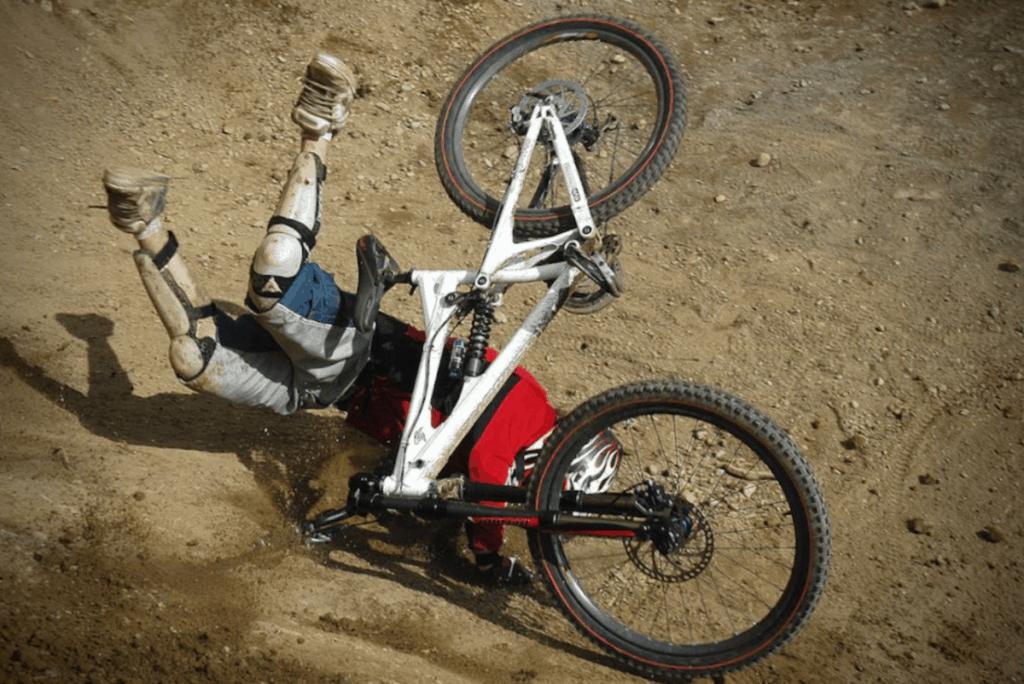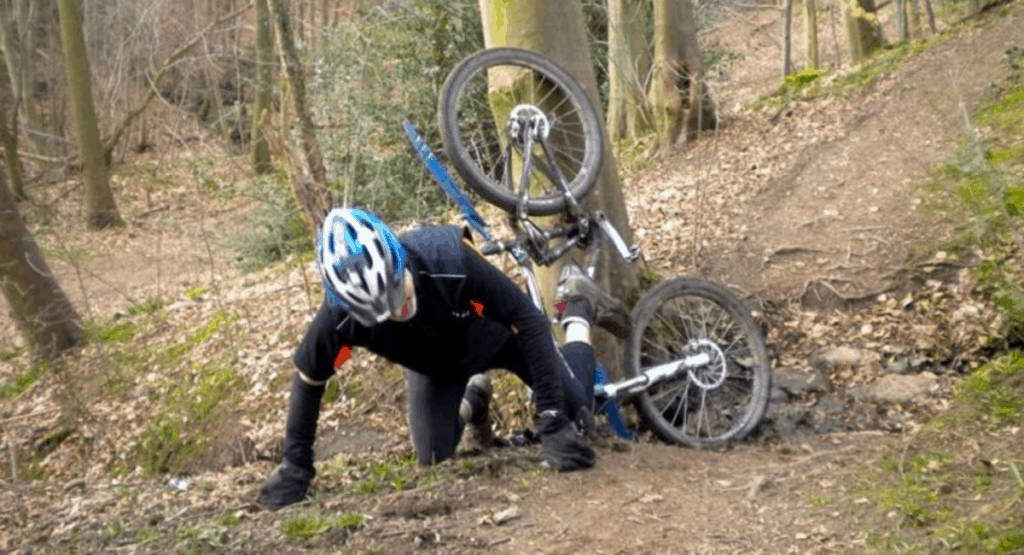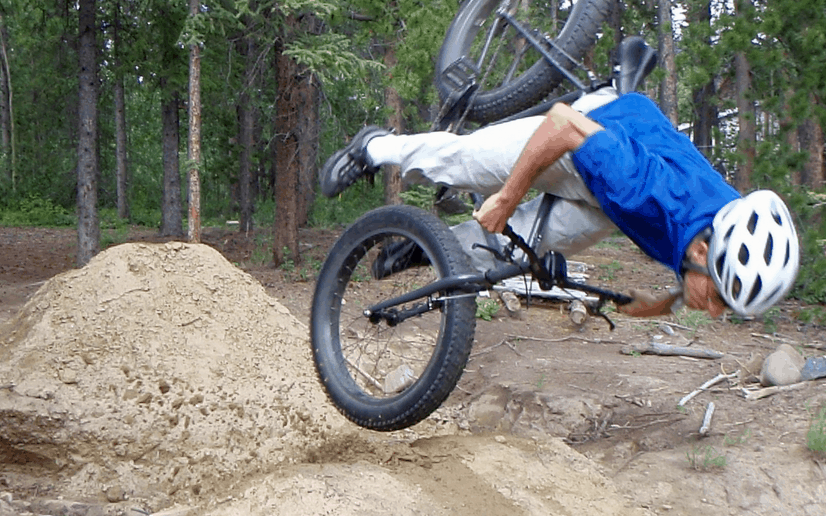Falling off your bike while mountain biking is bound to happen to all of us at some point. That being said there are many actions you can take to prevent yourself from a crash. In this post I’ll share 9 tips that will help you stay safe and injury free while mountain biking. Going over the bars isn’t a great feeling so here are some ways you can mountain bike with more confidence and less fear.
- Get Your Weight Behind The Bike
- Study The Trail Ahead & Pick A Good Line
- Get Coaching From A More Experienced Rider
- Improve Your Mountain Biking Fitness Level
- Where The Proper Body Protection
- Pack Enough Nutrition & Hydration For The Ride
- Avoid Riding In Bad Conditions
- Make Sure Your Bike Is Properly Set Up
- Ride Within Your Skill Level
1 – Get Your Weight Behind The Bike
This is my first tip for a good reason. Going over the bars is probably the worst type of crash while mountain biking. Going over the bars is normally caused by too much weight over your front wheel. If this happens you are susceptible to a neck injury or breaking a collarbone which will have you sidelined or out of commission for a long time. So how do we prevent ourselves from going over the bars.
The secret is keeping your weight distribution towards the back of the bike. These crashes normally happen on a descent or high speed areas of the trail. When you find yourself in these situations be sure to shift your weight to the back of the bike. Think about getting your body weight behind the bike.

Having a dropper post in these situations makes this so much easier. The dropper seatpost will lower so that you can easily get your body behind the seat completely. You’ll immediately feel more secure on the bike as your center of gravity is keeping both of your tires firmly on the ground. Once you finish the downhill or high speed area of trail you can release the dropper seat back to it’s normal position.
If you don’t have a dropper seat you can still shift your weight back but you’ll need to be a little more agile and flexible. You’ll also be in a vulnerable position because the seat will be directly in front of your private parts if you end up wiping out anyways. Ouch!! If you don’t have a dropper seat it might be worth the investment!
2 – Study The Trail Ahead & Pick A Good Line
Keeping your head and vision up while mountain biking can keep you safe out on the trail. Many crashes will happen when you simply don’t see that root or rock soon enough. Build the discipline to keep focused on the trail ahead.
Choosing good lines is a fundamental of mountain biking. Finding the best and safest line during your ride will go a long way to avoid crashing. Here are a few examples that are common in mountain biking where picking the correct line could mean the difference between wiping out and crashing.
- Cornering With Gravel – Some corners on trails with build up with extra gravel. If you approach this section pick a line that is higher above the loose gravel and sand. If you go to low into the corner you likely to slip out and crash. Going high on the corner with firm dirt will get you through easy.
- Don’t Get Trapped In Rain Ruts – Rain ruts are common on mountain biking trails especially after heavy rains. Getting your front wheel trapped in a rain rut will send you flying. To avoid this you really need to focus on steering clear of the rain ruts if you need to cross it come at the rain rut from a cross angle. If you ride too parallel you will likely sink in and crash.
- Spot The Rocks and Roots – Avoid the rocks and roots as you navigate the trail. If you simply can’t avoid them be prepared to lift your front wheel to go over the top. Vision ahead is key here because if you spot it early you can get your body into the correct position to make the maneuver.
- Float Through The Sand – Sand is another nemesis of mountain biking. Sometimes its tough to see it so you’ve really got to focus or remember the sandy parts of the trail if you ride the same trail often. If you are traveling at a high speed into sand you might wipe out. To avoid this try to just float through the sand and don’t make any turns until you navigate through it.
3 – Get Coaching From A More Experienced Rider
One of the best ways to avoid crashing is to improve your skills as a mountain biker. Experience on the trails will help you improve. Getting coached up from an experienced rider will accelerate your learning curve and you make you a better rider much faster.
There are many different ways to get coaching from mountain bike pros. Here are a few resources that you can use:
- YouTube.com – YouTube is loaded with experienced riders that offer excellent tips and strategies to improve your mountain biking skills. My top channels for mountain biking are: GMBN – Global Mountain Bike Network & PinkBike.
- Local Bike Clubs – Local clubs will have weekly rides with mountain bikers of all skill levels. Going on these rides is a great way to pick more experienced riders brains on how to handle different parts of the trail.
- Hire A Trainer Or Take A Course – This method is a little tougher to find but most major cities will have a mountain bike course you can take or a trainer that can ride with you and show you the ropes as you start out.
4 – Improve Your Mountain Biking Fitness Level
Fatigue plays a big role in many crashes. There are moments during a ride where the trail can test your fitness. If you get too fatigued you’ll miss something on the trail or just be too tired to make an adjustment and BOOM you are on the ground.
Here are a few strategies to make sure you don’t crash because of lack of fitness.
- Recognize where you are at from a fitness perspective. Don’t increase the duration of your rides too drastically. An example would be going from riding short 1 our trips to all of a sudden taking on a long 4 hour ride. It’s best to work up to it with a few 2 and 3 hour rides.
- Learn to respect the inclines. Not all trails are the same and some trails are incredibly steep and the climbing can really wear you out. Make sure you don’t take on a really steep incline until you are ready.
- Cross train to build up your fitness levels. Cross training with weight lifting will build stronger muscles and help prevent you from injury. You could also mix in some yoga to help with your flexibility which in the end will allow you to be better at body positioning on a mountain bike. Running and swimming will also increase your endurance for those steep inclines and long rides.
- Try to mountain bike at least 3 times a week. Riding at lease 3 times a week will build your fitness levels for mountain biking and also give you experience on the trails. Even if its a quick loop try to get out on the trail at least 3 times a week.
5 – Where The Proper Body Protection
Wearing the right protective gear might not prevent a crash but it’s in my top 9 because if you do crash it’ll prevent an injury. In the end we are really just trying to prevent injuries.

Getting geared up takes time and many mountain bikers will just slip on a helmet and hit the trail. It can be a pain but its absolutely worth taking the time and getting geared up. Here are some items I would recommend when riding.
- Wrist Guards – If you ditch the bike your wrists will be the first thing to stop you from hitting the ground. Avoid the broken wrist and wear a wrist guard.
- Elbow Pads – The elbow is next up and you will get some nice trail rash without them.
- Knee Pads – Bloody knees are common when you fall off your bike. This is a simple injury to prevent with wearing knee pads.
- Gloves – Avoid getting blisters on your hands and wear gloves. It’ll also prevent your hands from slipping off the handle bars when you’re sweating.
- Ankle Support & Shin Guards – I would look into wearing ankle supports and shin guards if you plan on leaving the ground a lot. When you go off jumps it’s a long way down and haveing the ankle support will prevent rolling your ankle. Shin guards will protect you from the pedals hitting your lower leg.
6 – Pack Enough Nutrition & Hydration For The Ride
Getting dehydrated can lead to fatigue and loss of focus. Those two factors can lead to big time crashes on the trails. Be sure to pack a camelbak loaded with water. Who cares if you pack too much but not enough is a path too disaster.
This is especially the case when mountain biking because you are normally out on the trails with no source of water nearby.
Here is an article that digs into the science behind how much water you should drink when exercising or mountain biking.
If you are going on a long ride it’s important to also pack up enough nutrition to have calories on the ride. A couple good ideas for nutrition would be:
- Protein Bars
- Almonds
- Banana
- Apple
- Nutritional supplements like “Gu’s” from Gu Energy Labs
7 – Avoid Riding In Bad Conditions
Riding in bad conditions is a recipe for disaster. Rainy, icy, snowy, wet or foggy conditions are all environmental situations that make mountain biking more dangerous.
Some mountain bikers will ride in these conditions regardless. That’s understandable especially if these riders live in areas that these conditions are more common. Just understand that the chances of crashing in these conditions is much higher than with dry conditions.
Outside of the weather there are also obstacles that could be built in a way that make the conditions for attempting them more dangerous. Here are just a few examples:
- Poorly Built Jumps – If a jump is built improperly it could be really hard to successfully navigate the jump. In these situations you might see some experienced riders handling the jump. Don’t get caught up with the “Keeping Up Mentality”. It’s better to recongnize this and find another jump that’s built for your level.
- Wet Wall Rides – If you ride in the morning you might find some of the wall rides slippery. If wood gets wet it is really tough to get traction on a mountain bike. It’s best to just wait until the wall ride drys out and then ride it safely.
8 – Make Sure Your Bike Is Properly Set Up
Having a properly set up bike is key in avoiding a crash. A few things to think about are purchasing the right sized bike for you, seat level, handle bar set up, shock set up and lever set up.
- Bike Size – Did you purchase the right size bike for your height and weight. There are many factors that go into the right bike for you. Be sure to connect with a professional bike fitter so that you are riding a bike that matches your body type.
- Seat Level – We touched on this above with a dropper seat. Having a seat too high will not allow you to get into the right body position. This could lead to lots of wipe outs. Be sure to get your seat height dialed in. If you add a dropper seat you’ll want to make sure you are a set up correctly for both levels.
- Handle Bar Set Up – Wide handle bars are more common these days and make for easier handling on a mountain bike. If you don’t have wide handle bars just make sure you adjust them to a comfortable position while riding.
- Shock Set up – As an example if you have to much pressure in your rear shocks you’ll find yourself going over the bars when going off jumps. Be sure to set your shocks up for the type of riding you’ll be doing.
- Lever Set Up – Having an improper lever setup has been the cause of many wrecks. Imagine heading into a drop and trying to hit your dropper seat lever but your thumb can’t quite reach easily…too late you are not heading down the hill in your high position and before you know it your over the bars. Be sure to put your levers in a position that you can easily tap those brakes and hit your dropper seat trigger with ease.
9 – Ride Within Your Skill Level
Mountain biking is a skill you will improve over the course of life. Riders get in trouble when they try to ride outside of their comfort zone. A few of the reasons are peer pressure, time constraint, picking the wrong trail and following a more experienced friend.
- Peer Pressure – If you ride in a mountain biking group you might have a Saturday ride at a more difficult trail. Some trails will only offer one option and you find yourself heading into drops that you simply weren’t ready for. Rather than getting off your bike and walking down the drop you’ll attempt it and find yourself in the bushes. Don’t let peer pressure take you down trails you’re not ready for…yet!
- Time Constraints – Sometimes we try to ride in a short period of time. If you have places to be that force you to ride faster than usual you’ll find yourself pushing your comfort zone and this could lead to a crash. Try to give yourself ample time for a ride.
- Picking The Wrong Trail – Do some homework before you head out riding. You don’t want to be on a trail that is simple more advanced than your skill level. Find the option that matches where you’re at and take that one instead. Some trails will have options for beginner, intermediate and advanced. Not all do though, so be sure to avoid trails that only offer trails that are beyond your current skill level.
- Following A More Experienced Friend – This is a common occurrence in mountain biking. Many riders prefer to ride with a friend to be safer on the trails. It’s always good practice to ride with a friend in case something goes sideways. The only time this can be a problem is if you feel pressured to ride out of your skill level. I would just let your buddy know where you’re at and that you’ll be a long but it might take you a little longer than him.
Conclusion
I hope you got some value out of these 9 tips. Stay safe out there and avoid crashing!

